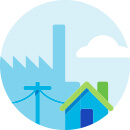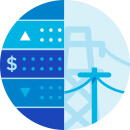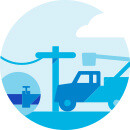How Energy Choice Works
For much of the 20th Century, customers received their electricity and natural gas supply from the local utility. That all changed when energy choice (sometimes called deregulation) came to town...
How Energy Choice Works
For much of the 20th Century, customers received their electricity and natural gas supply from the local utility. That all changed when energy choice (sometimes called deregulation) came to town...
How Energy Choice Works
For much of the 20th Century, customers received their electricity and natural gas supply from the local utility. That all changed when energy choice (sometimes called deregulation) came to town...

Local utilities were legal monopolies, with regulated rates that guaranteed a reasonable profit in return for providing reliable service.
This model helped the country build out a large infrastructure to accommodate rapidly growing demand, but left little incentive for advances in customer service or product innovation.

Beginning in the late 90’s, several states discovered value in the competitive energy market, and moved to separate the ’supply’ of energy from its ‘delivery.’ Customers in those states could choose a retail energy supplier (an alternative to their utility), to purchase the energy their home uses directly from commodity trade markets.

Today, customers in states that allow energy choice can buy natural gas and electricity from a supplier of their choice – with each competing to win their business and keep them as a satisfied customer.

In addition to competitive rates and great customer service, this competition motivates energy suppliers to offer renewable energy options, including plans that include a mix of wind, solar, and hydro-driven energy.

No matter your supplier, your delivery of energy, and emergency response will remain the same.
As a result, customers in states with energy choice may enjoy additional rewards and benefits.










